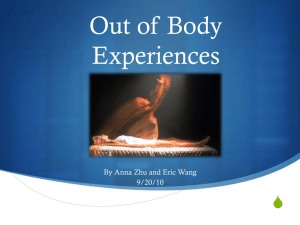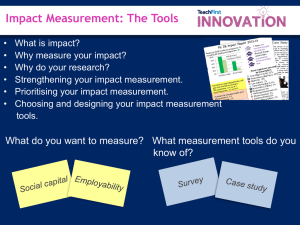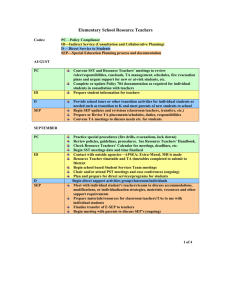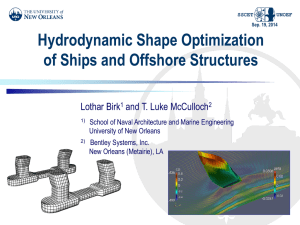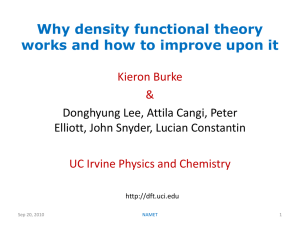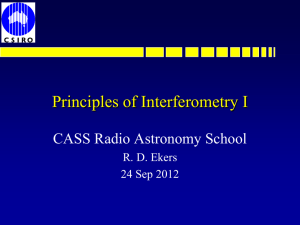Working with Wind Energy
advertisement
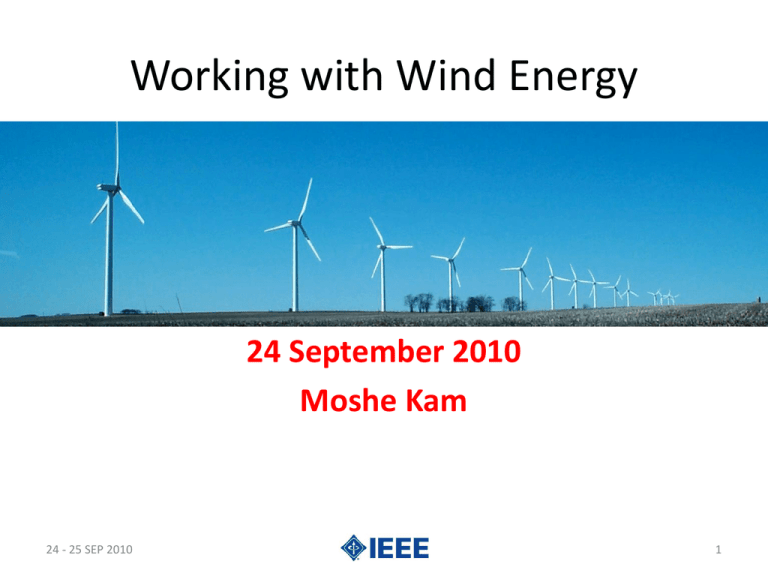
Working with Wind Energy 24 September 2010 Moshe Kam 24 - 25 SEP 2010 1 Activity Goal • Build a wind turbine with simple materials • The wind turbine must withstand the wind generated by a fan or hair dryer and rotate for up to 1 minute to lift a small object 24 - 25 SEP 2010 2 Activity Objectives • • • • • Learn about wind energy conversion Design a wind turbine Construct the wind turbine Test the wind turbine Evaluate Performance 24 - 25 SEP 2010 3 Why is this experiment useful to teachers and students? • Learn about wind energy and wind turbines • Learn about the concepts of forces and motion • Learn about engineering design • Learn how engineering can help solve societal challenges • Learn about teamwork and problem solving 24 - 25 SEP 2010 4 Principles & Standards for School Mathematics • Geometry: – Use visualization, spatial reasoning, and geometric modeling to solve problems – Analyze characteristics and properties of two- and threedimensional geometric shapes and develop mathematical arguments about geometric relationships • Problem Solving: – Recognize and apply geometric ideas in areas outside of the mathematics classroom – Apply and adapt a variety of appropriate strategies • Communication: – Communicate mathematical thinking coherently and clearly to peers, teachers, and others 24 - 25 SEP 2010 5 What is Wind? • Wind is a form of Solar Energy • The sun heats the Earth’s surface at varying rates • The air above the warmer areas heats up, becomes less dense and rises • Cooler air from adjacent higher-pressure areas moves to the lower-pressure areas • That movement = wind 24 - 25 SEP 2010 6 Where in the World is Wind? 24 - 25 SEP 2010 7 What is Wind Energy? • The process by which the wind is used to generate mechanical energy or electricity • Wind turbines convert the kinetic energy in the wind into mechanical and electrical energy 24 - 25 SEP 2010 8 24 - 25 SEP 2010 9 A Wind Turbine • The wind hits the blades… • Shaft leads to a gearbox whose output leads to a generator to make electricity • Usually has 2 or 3 blades 24 - 25 SEP 2010 WIND 10 The Turbine Blade • Operates much like an airplane wing • Low-pressure air forms on the downwind side of the blade • The low-pressure air pocket then pulls the blade toward it, causing the rotor to turn 24 - 25 SEP 2010 11 Many blade designs 24 - 25 SEP 2010 12 Your Challenge • Design, construct and test your own wind turbine design • Wind up weight 15 cm as quickly as possible • Maximum 1 minute • No human interaction! • Blowdryer at least 30cm away from turbine 24 - 25 SEP 2010 > 1ft, 30cm 13 Turbine Requirements • Must have a rotor shaft around which to wind up given weight • Must be freestanding (no human interaction) • Must use only materials provided 24 - 25 SEP 2010 > 1ft, 30cm 14 Test Procedure • Blowdryer at least 30 cm away from turbine • No human interaction with turbine • Attach weight around rotor • Up to 1 minute to wind up weight • Record time to wind up weight 24 - 25 SEP 2010 > 1ft, 30cm 15 Materials • • • • • • • • • • wooden sticks, spoons bendable wire string paperclips rubber bands toothpicks aluminum foil, plastic wrap tape, glue wooden dowels paper, cardboard 24 - 25 SEP 2010 16 Procedure • • • • • • Teams of 2 Develop and sketch your design Construct initial design Preliminary test Modify design, if necessary Final test 24 - 25 SEP 2010 17 Evaluate Your Design • Efficiency of design may depend on – Cost of materials – Speed (rotations per minute) – Power (time to wind weight) • Possible measure of efficiency: – Eff. = (Cost of materals) / (time [sec] to wind weight) • Are two designs that have the same rotational speed equally as “good”? 24 - 25 SEP 2010 18



